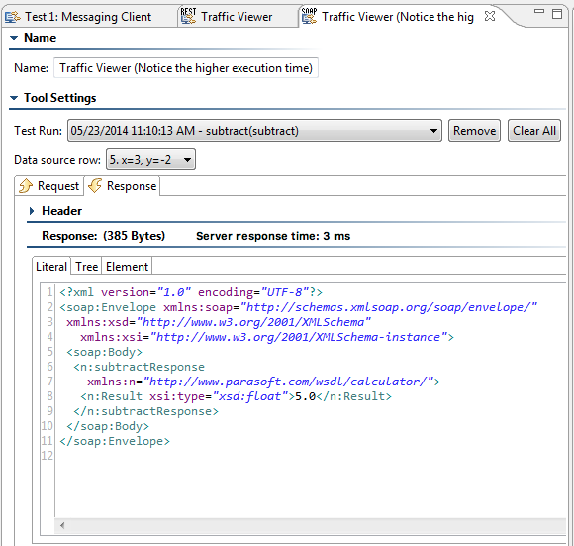This topic explains how to configure the Traffic Viewer tool that displays the traffic (request and response) for the tool to which it is attached.
Sections include:
Understanding the Traffic Viewer
Each time you run a tool, SOAtest will automatically record the traffic to and from the designated endpoint. The Traffic Viewer tool helps you to manage and visualize the requests and responses associated with each tool. The Traffic Viewer can record multiple instances of traffic that correspond to each tool run.
Using the Traffic Viewer Tool
After a tool is executed, double-click the Traffic Viewer node beneath the test to view that tool’s traffic. The following components are available in the Traffic Viewer tool:
- Test Run: Displays the timestamp of the selected test case.
- Remove: Click to delete the selected Traffic instance from the Test Run drop-down menu.
- Clear All: Click to delete all the Traffic instances from the Test Run drop-down menu.
- Save Traffic: Select to save traffic data (requests and responses). If this option is not selected, traffic will be lost after the project is closed.
- Request URLs: (Only available when attached to a Browser Playback tool): Shows the various browser request URLs for which traffic is available.
- Data Source Row: Displays data source row values sent within the traffic. (The Data Source Row menu only displays if a data source was used for the corresponding test case).
- Request/Response tabs: Displays the Request or Response Header and Body that corresponds to the selected test from the Test Run drop-down menu and also (if applicable) to the selected Data Source Row.
For client and stub tools, you can view the request and response body via three different tabs:
- Literal: This tab is shown by default. If you find that you have to scroll from left to right to view the traffic, you can right-click within the tab, then choose Beautify. You can also reformat XML to fit on one line by right-clicking in the tab and choosing Compact.
- Tree: The Tree tab allows you to view the Response body via a tree view.
- Element: The Element tab allows you to view a simplified version of the message.
Table Tab - for Database Query Results
If the Traffic Viewer is attached to a DB tool and a "SELECT" statement is executed by the DB tool, the Response area will show a table that contains the results of the DB query.
When a DB tool executes multiple SQL statements and the response includes multiple result sets, you can use the combo box (above the table when there are multiple result sets) to determine which result set’s traffic is shown.
Here, the traffic viewer is showing the results for Result Set 2:
Related Tutorials
The following tutorial lesson demonstrates how to use this tool:


